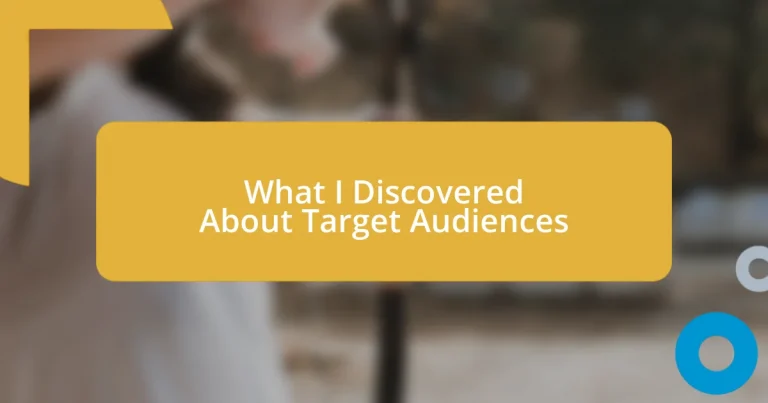Key takeaways:
- Engagement with the target audience requires deep understanding of their needs, motivations, and emotions beyond basic demographics.
- Utilizing qualitative research methods, such as surveys and focus groups, allows for rich insights that shape effective customer personas and marketing strategies.
- Flexibility and collaboration across teams enhance the ability to adapt strategies based on audience feedback, leading to improved customer satisfaction and engagement.

Understanding target audience needs
Understanding the needs of a target audience goes beyond simple demographics; it requires diving deep into their motivations and pain points. I remember working on a marketing project where I assumed that age alone defined the preferences of my audience. It wasn’t until I engaged with them directly that I discovered their true needs—much more related to lifestyle and values than to age. Have you ever misjudged what people truly care about? It’s a humbling experience that underscores the importance of direct interaction.
When I analyze target audience needs, I often rely on empathy. For instance, while creating content for a health product, I connected with users through their struggles and aspirations. It amazed me how powerful it was to understand their emotional journey—even just offering a listening ear can unlock deeper insights. Aren’t we all looking for understanding, especially when it comes to our personal challenges?
Moreover, I’ve found that the language your audience uses reveals so much about their needs. During another project, I started incorporating feedback from customer reviews and found that just a few tweaks in diction made the material resonate better. It was like turning a dull light bulb into a vibrant one. How often do we overlook their words as a source of insight? Listening to them will not only guide your efforts but also create a genuine connection.
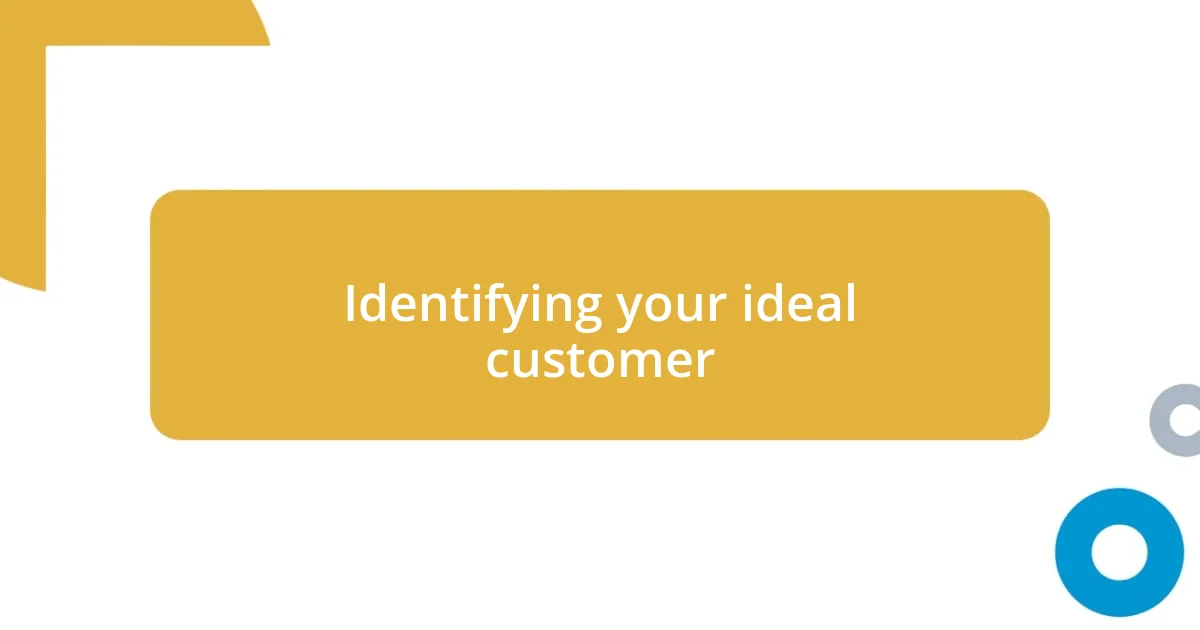
Identifying your ideal customer
Identifying your ideal customer is a nuanced process that goes beyond surface-level traits. I remember launching a campaign for a tech startup and assuming our ideal customer would just be young professionals. While that demographic was a component, I quickly realized that understanding their tech-savviness, lifestyle, and how our product fit into their daily routines was essential. Have you ever found yourself stuck in a box, only to discover there was so much more outside of it?
In my experience, utilizing surveys and feedback is invaluable. I once crafted a set of open-ended questions for an online store. The responses were illuminating; customers shared not just their buying habits but also their dreams and frustrations surrounding the products. What surprised me was how much personal stories shaped purchasing decisions. Do we underestimate the power of listening deeply to what customers have to say?
Creating customer personas can also streamline your efforts in identifying your ideal audience. By combining demographic data, motivations, and even personal anecdotes from your audience, you can paint a comprehensive picture. I found this approach particularly useful when tailoring a campaign for a non-profit organization. The personas brought their values and aspirations to life, making it easier to connect emotionally and authentically with the target audience. Isn’t it fascinating how a well-structured persona can feel almost like a real person?
| Method | Benefits |
|---|---|
| Surveys | Direct insights from your audience regarding preferences and motivations. |
| Customer personas | Help visualize your ideal customer, making marketing efforts more targeted. |
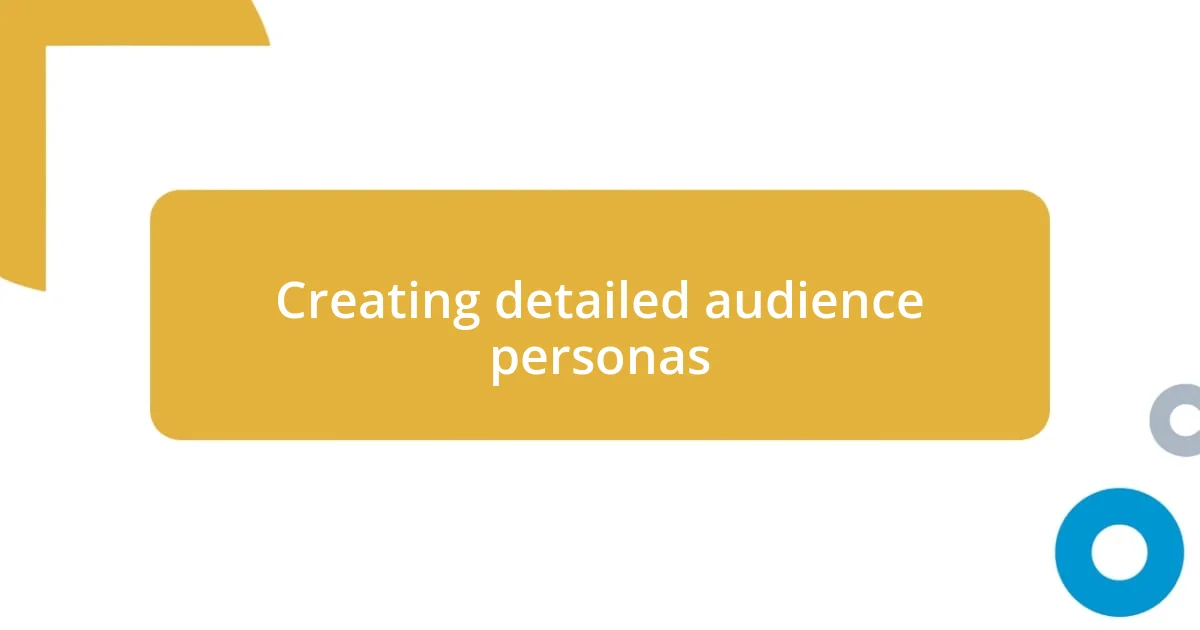
Creating detailed audience personas
Creating detailed audience personas takes time and attention to nuance. I recall a project where I spent hours interviewing customers, delving not just into their preferences but also their daily lives and emotional connections to the product. This experience was eye-opening; it reminded me that understanding your audience means considering their experiences and how they relate to the world around them. Sometimes, it feels like peeling an onion—each layer reveals more about who they are.
To build effective audience personas, consider the following aspects:
- Demographics: Age, gender, and income level provide a foundation.
- Psychographics: What are their interests, beliefs, and values?
- Pain Points: Understanding the challenges they face helps tailor solutions.
- Behavioral Aspects: What influences their purchasing decisions?
- Goals and Aspirations: What do they hope to achieve, both personally and professionally?
Each of these components adds depth to your audience personas, transforming them from just a collection of traits into relatable profiles. I learned this firsthand while developing a campaign aimed at fitness enthusiasts, which was more than just knowing they liked exercise; it involved recognizing their motivations to lead healthier and more fulfilling lives. When I brought these personas to the team, you could feel the energy shift—it was like connecting dots that had previously seemed disconnected.
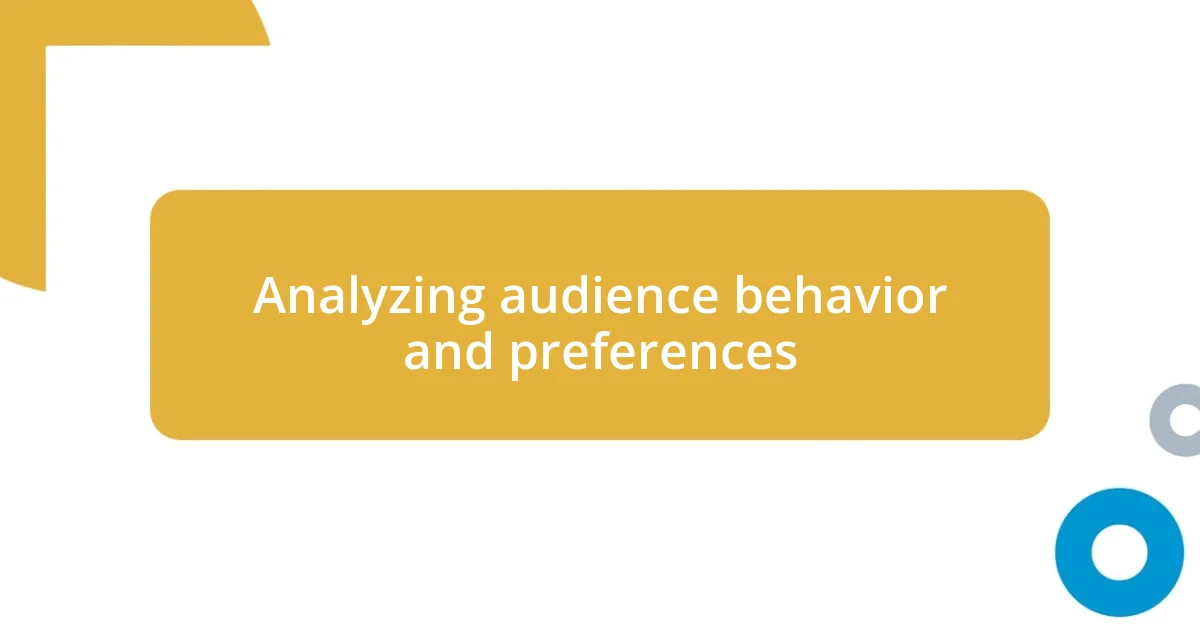
Analyzing audience behavior and preferences
Understanding audience behavior and preferences is like detective work; each insight can lead to a deeper understanding of what drives consumer choices. I once monitored customer interactions on social media, and the variety of responses to a single post was striking. Have you ever noticed how one person’s praise can spark a wave of criticism? This dichotomy revealed not just preferences but also the underlying emotions tied to our product.
Digging into analytics is another powerful tool that I learned to appreciate. When I analyzed website traffic, I was fascinated to find that certain pages had higher engagement rates because they resonated with audience pain points. For instance, one product description highlighting a user’s story significantly increased click-through rates. It made me wonder: how often do we overlook the human element in our data?
Finally, I found qualitative research to be incredibly revealing. One time, I hosted a focus group, and the discussions turned into a tapestry of experiences. Listening to participants openly share how our product impacted their lives was illuminating. It struck me that these heartfelt stories not only shaped preferences but also created a community around our brand. Isn’t it amazing how understanding isn’t just about numbers? It’s about connecting on a deeper level.

Conducting market research effectively
Conducting market research effectively requires a mix of quantitative and qualitative methods to uncover the true motivations of your audience. I remember leading a survey initiative that combined statistical data with open-ended questions. It was fascinating to see how the numbers alone didn’t capture the nuances of customer sentiment. For example, while many indicated they loved a specific feature of our product, their comments brought to light why it mattered to them on a personal level. Have you ever taken the time to read between the lines of direct feedback? It’s where the real gems often lie.
Another approach I found invaluable was leveraging social listening tools. During one campaign, I tuned into conversations around our brand—what people were saying and how they were feeling. The emotional tone of various discussions was incredibly telling; it revealed not just what customers liked but also their frustrations. It made me question: what are we not addressing that could enhance their experience? Seeing those real-world emotions helped us shift our strategy and make adjustments that resonated more with our audience.
Finally, integrating competitive analysis into my research toolkit offered an enriching perspective. Venturing beyond our own brand, I studied how similar companies positioned themselves and how audiences responded. I distinctly recall a competitor’s misstep that highlighted a gap in their approach, which we could fill. This kind of insight pushed me to ask, how can we differentiate ourselves while still meeting the needs of our target consumers? Gaining clarity through research doesn’t just inform decisions; it inspires creative strategies that can set your brand apart.
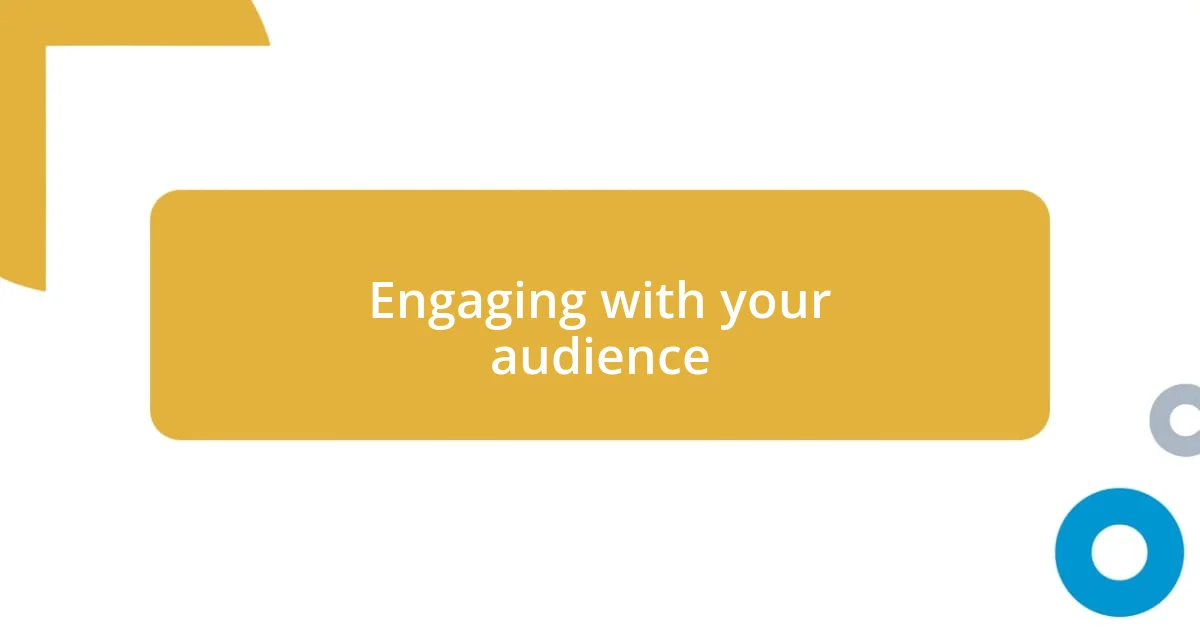
Engaging with your audience
Engaging with your audience goes far beyond just presenting your product or service; it’s about creating genuine connections. I vividly remember a campaign where we asked our followers to share their favorite experiences with our brand. The heartfelt stories that poured in not only warmed my heart but also allowed me to see our brand through our customers’ eyes. Have you ever considered how sharing personal stories can transform mere customers into brand advocates?
In my experience, personalization is key to fostering engagement. For instance, I recall sending a targeted email campaign celebrating customers’ birthdays, and the response was beyond what I expected. The messages of genuine gratitude poured in, proving that when customers feel valued, their loyalty deepens. It made me reflect: what small gestures can we implement to show our clients they matter?
Feedback loops are another essential piece of the engagement puzzle. I used to run surveys after product launches, but I realized that merely asking wasn’t enough—the real magic unfolded when I acted on that feedback. One time, based on customer suggestions, we tweaked a feature that was underwhelming. The improved response not only lifted our sales but also gave our audience a sense of ownership over the product. Isn’t it powerful to think that your customers can influence the evolution of your brand? Engaging with them this way transforms the whole relationship into a collaborative journey.
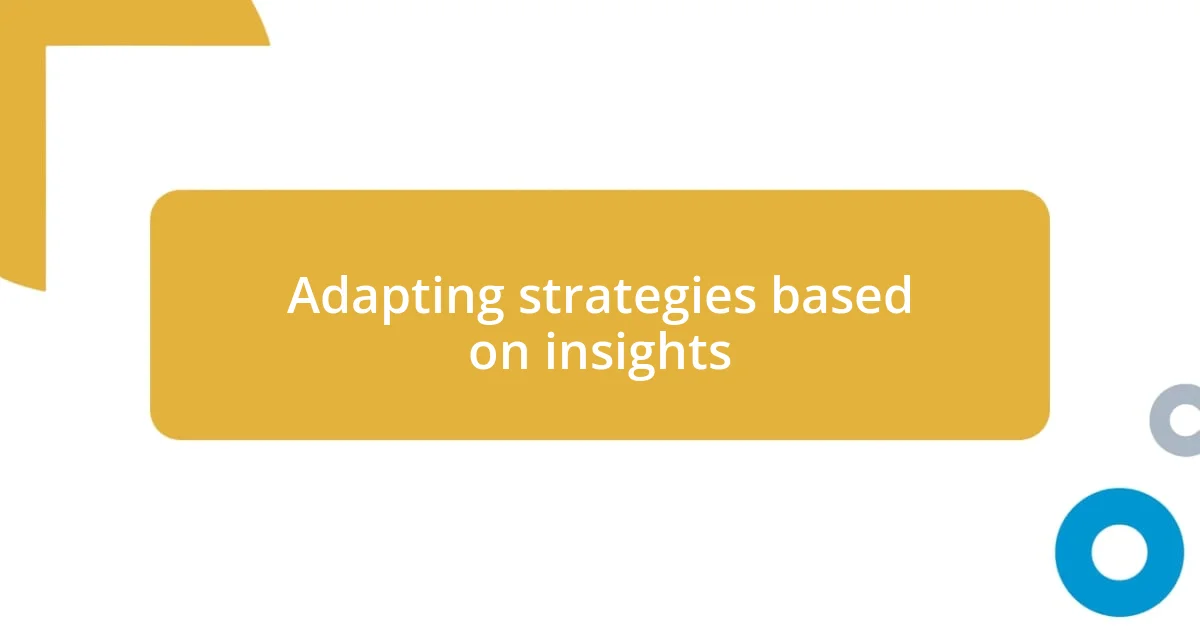
Adapting strategies based on insights
When it comes to adapting strategies based on insights, I’ve often found that flexibility is crucial. Once, after analyzing customer feedback from a new product launch, I noticed a persistent theme: users loved the product but struggled with understanding certain features. This led me to rethink our approach and create simple tutorial videos. Have you ever made a small adjustment that yielded massive results? That shift not only improved customer satisfaction but also boosted sales, reinforcing my belief in the power of listening to your audience.
In another instance, I was managing a social media campaign and stumbled upon an emerging trend among our target demographic that we hadn’t initially considered. By pivoting our messaging to incorporate this trend, we saw engagement rates skyrocket. It made me realize that staying attuned to the evolving landscape of your audience’s interests can open doors. I often ask myself, how can we remain agile enough to seize such opportunities? Those moments of insight can transform our strategies from reactive to proactive, making us more relevant in a fast-paced market.
I also learned that collaborating with cross-functional teams can amplify the impact of our insights. Once, while brainstorming with the product development team, we fused insights from customer service interactions with our marketing strategy. This collaboration led to the creation of a campaign that addressed both common queries and showcased our product’s strengths. The sense of teamwork sparked innovation I hadn’t anticipated. Have you experienced a breakthrough when diverse perspectives come together? I truly believe that by embracing insights from various areas of expertise, we can adapt our strategies to create a more holistic approach that resonates with our target audience.












